Hello everyone. This week, LCSC Electronics partner and supplier SIT introduces CAN FD transceiver products. Help you understand the ringing suppression function of the SIT1043Q CAN transceiver.
With the in-depth development of new energy vehicles and autonomous driving technology, the CAN communication rate has increased from the basic 125kbps rate to the current 8Mbps rate application. The higher the communication rate, the higher the quality requirements for the CAN transceiver differential signal. SIT R&D engineers built a ringing suppression circuit into the SIT1043Q chip, which serves to improve the quality of high-speed communication signals in star networks without adding any external components (star network shown in Figure 1), making it The SIT1043Q CAN FD transceiver can support communication rates of 5Mbps~8Mbps without the need for large-scale network architecture redesign.
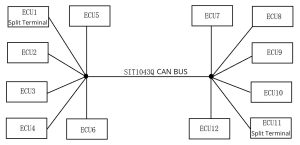
SIT1043Q CAN FD Transceiver Signal Enhancement (SIC)
SIC is the abbreviation of Signal Improvement Capability. While the SIT1043Q CAN FD transceiver realizes ultra-low power consumption applications, the chip further improves the SIC function.
1.Adding a slope control circuit improves the consistency and symmetry of the bus signal. It shortens the bus signal rising edge and falling edge climbing slope, reduces the signal loop time;
2.SIT adds a ringing suppression circuit to suppress dominant level to recessive level signal oscillation under high-speed communication.
Figure 2 shows a conventional CAN FD transceiver where the CAN bus signal rings above 900 mV and below 500 mV, causing differential signal bit tearing and tearing of the receive data (RXD) signal. And figure 3 shows the CAN FD transceiver with SIC functionality, resulting in the complete RXD signal.
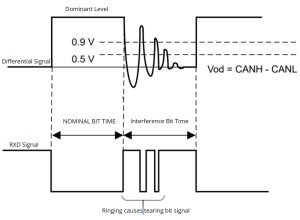
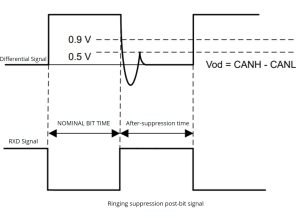
SIT1043Q CAN FD Transceiver Ringing Implementation Principle
The CAN bus has two logical states during normal communication: recessive level and dominant level, as shown in Figure 4. When driving the bus differentially, the bus is in a dominant state. It corresponds to a logic low on the TXD and RXD pins. When the bus is biased to VCC/2 through the high-value input resistor inside the receiver, the bus is in a recessive state, corresponding to a logic high on the TXD and RXD pins. In principle, the recessive to dominant signal edges on the CAN bus are usually not prone to ringing because the CAN transceiver has strong driving capability. At the same time, the transmitter output impedance of the CAN transceiver in the dominant stage is about 50Ω, which closely matches the characteristic impedance of the CAN network.
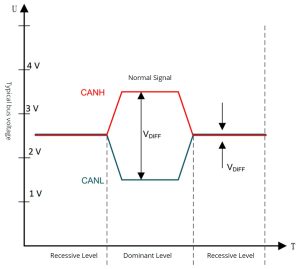
When the bus signal changes from dominant to recessive level, the differential output impedance of the CAN driver suddenly changes to about 30kΩ without ringing suppression. The reflected signal encounters an impedance mismatch, causing an oscillation signal on the dominant to recessive edge. It results in the bus signal ringing. To effectively suppress the signal ringing caused by the bus load when switching from explicit to recessive, SIT1043Q has a built-in ringing suppression circuit. It detects the circuit through the bus feedback. When the signal threshold exceeds a fixed voltage, SIT1043Q automatically activates ringing suppression. Through the dynamic automatic load adjustment, the circuit achieved signal ringing suppression, reduced signal reflection, and achieved RXD bit signal integrity.
SIT1043Q CAN FD Transceiver Ringing Suppression Function Test
In a large-scale star network communication test (Figure 1), a 1043 chip CAN transceiver without ringing suppression (Figure 5) and the SIT1043Q integrated ringing suppression circuit CAN transceiver test comparison waveform in the same onboard environment(Figure 6). Judging from the single ringing test waveform effect, the RXD signal of SIT1043Q is complete, and the ringing suppression effect is good. However, the RXD bit signal is torn and incomplete for the CAN transceiver without ringing suppression. In addition, this chip serves in body control, intelligent cockpit, domain controller, T-Box, ADAS, smart gateway, chassis power system, etc. SIT1043Q CAN FD transceiver is a chip with good performance with feedback through actual project applications. SIT recommended the SIT1043Q CAN FD transceiver for everyone to choose and use.
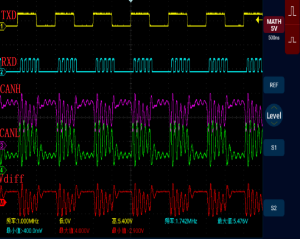
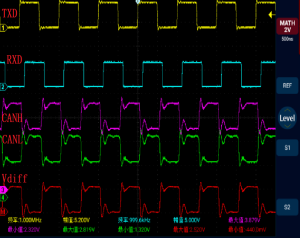
SIT CAN FD Transceiver Product List
| Part Number | Supply Voltage(s)
(V) |
Signaling
Rate (Mbps) |
Wake up
&Sleep |
Low power Current
(uA) |
Bus Fault
Protection Voltage |
Package | Pin to pin |
| SIT1044QT | 4.75~5.25 | 0.015-5 | Standby
Bus Wake up |
15 | -40~40 | SOP8 | TJA1044T |
| SIT1044QT/3 | 4.75~5.25
3.3v IO |
0.015-5 | Standby
Bus Wake up |
5 | -40~40 | SOP8 | TJA1044T/3 |
| SIT1044QTK/3 | 4.5~5.5
3.3v IO |
0.015-5 | Standby
Bus Wake up |
5 | -40~40 | DFN3*3-8(HVSON8) | TJA1044TK/3 |
| SIT1042AQT | 4.5~5.5 | 0.015-5 | Standby
Bus Wake up |
12 | -58~58 | SOP8 | TJA1042T |
| SIT1042AQT/3 | 4.5~5.5
3.3v IO |
0.015-5 | Standby
Bus Wake up |
0.5 | -58~58 | SOP8 | TJA1042T/3 |
| SIT1042AQTK/3 | 4.5~5.5
3.3v IO |
0.015-5 | Standby
Bus Wake up |
0.5 | -58~58 | DNF3*3-8(HVSON8) | TJA1042TK/3 |
| SIT1051AQT | 4.5~5.5 | 0.015-5 | silent | 1000 | -58~58 | SOP8 | TJA1051T |
| SIT1051AQT/E | 4.5~5.5 | 0.015-5 | Low Current Off Hardware Wakeup | 0.5 | -58~58 | SOP8 | TJA1051T/E |
| SIT1051AQT/3 | 4.5~5.5
3.3v IO |
0.015-5 | silent | 1000 | -58~58 | Sop8 | TJA1051T/3 |
| SIT1051AQTK/3 | 4.5~5.5
3.3v IO |
0.015-5 | silent | 1000 | -58~58 | DNF3*3-8(HVSON8) | TJA1051TK/3 |
| SIT1043QT | VBAT=4.5-40
VCC=4.5-5.5 3.3v IO |
0.04-5 | Standby
Sleep |
16 | -58~58 | SOP14 | TJA1043T |
| SIT1043QTK | VBAT=4.5-40
VCC=4.5-5.5 3.3v IO |
0.04-5 | Standby
Sleep |
16 | -58~58 | DNF14(HVSON14) | TJA1043TK |
| SIT1057QT | 4.75~5.25 | 0.015-5 | silent | 1200 | -40~40 | SOP8 | TJA1057T |
| SIT1057QT/3 | 4.75~5.25
3.3v IO |
0.015-5 | silent | 1200 | -40~40 | SOP8 | TJA1057T/3 |
| SIT1057QTK/3 | 4.75~5.25
3.3v IO |
0.015-5 | silent | 1200 | -40~40 | DNF3*3-8(HVSON8) | TJA1057TK/3 |
| SIT1145AQT | VBAT=4.5-28
VCC=4.5-5.5 3.3v IO |
5 | Standby
Sleep |
48 | -58~58 | SOP14 | TJA1145AT |
| SIT1145AQTK | VBAT=4.5-28
VCC=4.5-5.5 3.3v IO |
5 | Standby
Sleep |
48 | -58~58 | DNF14(HVSON14) | TJA1145ATK |
Silicon Internet of Things Technology Co., Ltd (SIT) is an integrated circuit design enterprise. As the first analog IC manufacturer with both CAN and LIN transceiver chips in China, SIT has successively released more than 40 models of CAN, CAN FD, and LIN transceiver chips, with a cumulative shipment of more than 200 million.
Focusing on automotive electronics and industry, SIT provides personalized services for customers with high-quality products and professional technology. SIT has established in depth cooperation with over 10 OEMs and more than 600 Tier1/Tier2 manufacturers worldwide.
LCSC is the authorized distributor of SIT. It as founded in 2012 in Shenzhen, bordering Hong Kong. LCSC Electronics is committed to helping engineers and enterprises who purchase qualified electronic parts for samples and small production purposes. Based on that, LCSC guarantees every part is authentic and can be traceable to the original. After years of unremitting efforts, LCSC has become a global distributor with an extensive selection of electronic components, with more than 4 million registered customers worldwide. And the average daily order is about 14,000. Select SIT’s products at LCSC Electronics.
